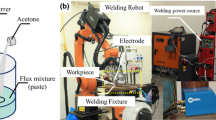Abstract
In this paper, welding residual stresses in an arc welded lap joint are evaluated by Finite element (FE) analysis of a continuum model considering Transformation induced plasticity (TRIP). The constitutive model for the plastic behavior including TRIP is implemented in user material subroutine (UMAT) of Abaqus/Standard. Numerical results are compared with experimentally measured residual stresses by X-ray diffraction technique. Moreover, the welding residual stresses in a continuum FE model are mapped to a simplified FE model using shell elements by moving least square approximation. The methodologies and results in this study show that the welding residual stresses in a local-level FE model of a welded joint can be mapped successfully to a simplified FE model.
Similar content being viewed by others
References
G. W. Greenwood and R. H. Johnson, The deformation of metals under small stresses during phase transformations, Proc. of the Royal Society of London A: Mathematical, Physical and Engineering Sciences, The Royal Society, 283 (1394) (1965) 403–422.
C. L. Magee and H. W. Paxton, Transformation kinetics, microplasticity and aging of martensite in Fe-31 Ni, Ph.D. Thesis, Carnegie Inst. of Tech. Pittsburgh, PA (1966).
L. Taleb and F. Sidoroff, A micromechanical modeling of the Greenwood–Johnson mechanism in transformation induced plasticity, International Journal of Plasticity, 19 (10) (2003) 1821–1842.
A. S. Oddy, J. A. Goldak and J. M. J. McDill, Transformation plasticity and residual stresses in single-pass repair welds, ASME Journal of Pressure Vessel Technology, 114 (1) (1992) 33–38.
J. Ronda and G. J. Oliver, Comparison of applicability of various thermo-viscoplastic constitutive models in modelling of welding, Computer Methods in Applied Mechanics and Engineering, 153 (3) (1998) 195–221.
M. Coret, S. Calloch and A. Combescure, Experimental study of the phase transformation plasticity of 16MND5 low carbon steel under multiaxial loading, International Journal of Plasticity, 18 (12) (2002) 1707–1727.
J. B. Leblond and J. Devaux, A new kinetic model for anisothermal metallurgical transformations in steels including effect of austenite grain size, Acta Metallurgica, 32 (1) (1984) 137–146.
J. B. Leblond, Mathematical modelling of transformation plasticity in steels II: Coupling with strain hardening phenomena, International Journal of Plasticity, 5 (6) (1989) 573–591.
J. Kim, S. Im and H.-G. Kim, Numerical implementation of a thermo-elastic–plastic constitutive equation in consideration of transformation plasticity in welding, International Journal of Plasticity, 21 (7) (2005) 1383–1408.
Y. S. Han, K. Lee, M. S. Han, H. Chang, K. Choi and S. Im, Finite element analysis of welding processes by way of hypoelasticity-based formulation, ASME Journal of Engineering Materials and Technology, 133 (2) (2011) 021003.
S. M. Afazov, A. A. Becker and T. H. Hyde, Mathematical modeling and implementation of residual stress mapping from microscale to macroscale finite element models, Journal of Manufacturing Science and Engineering, 134 (2) (2012) 021001.
S. I. Song, S. W. Ahn, Y. G. Kim and H.-G. Kim, Development of simplified finite element models for welded joints, Transactions of the Korean Society of Mechanical Engineers A, 39 (11) (2015) 1191–1198.
P. Lancaster and K. Salkauskas, Surfaces generated by moving least squares methods, Mathematics of Computation, 37 (1981) 141–158.
J. Goldak, A. Chakravarti and M. Bibby, A new finite element model for welding heat sources, Metallurgical Transactions B, 15 (2) (1984) 299–305.
M. Zubairuddin, S. K. Albert, S. Mahadevan, M. Vasudevan, V. Chaudhari and V. K. Suri, Experimental and finite element analysis of residual stress and distortion in GTA welding of modified 9Cr-1 Mo steel, Journal of Mechanics Science and Technology, 28 (12) (2014) 5095–5105.
Author information
Authors and Affiliations
Corresponding author
Additional information
Recommended by Associate Editor Jun-Sik Kim
Hyun-Gyu Kim is a Professor in Department of Mechanical and Automotive Engineering at Seoul National University of Science and Technology. His research interests are in the area of computational solid mechanics with a particular emphasis on computational fracture mechanics, plasticity and multi-scale analysis.
Rights and permissions
About this article
Cite this article
Kim, HY., Kim, HG. Numerical and experimental analysis of residual stresses in an arc welded lap joint and mapping of the residual stress field to a simplified finite element model. J Mech Sci Technol 31, 4895–4902 (2017). https://doi.org/10.1007/s12206-017-0937-z
Received:
Revised:
Accepted:
Published:
Issue Date:
DOI: https://doi.org/10.1007/s12206-017-0937-z




